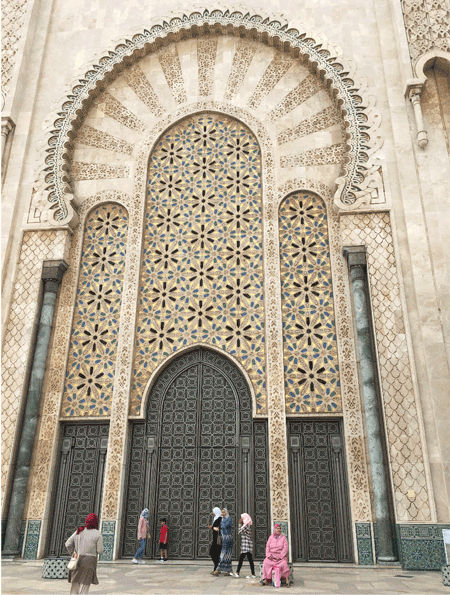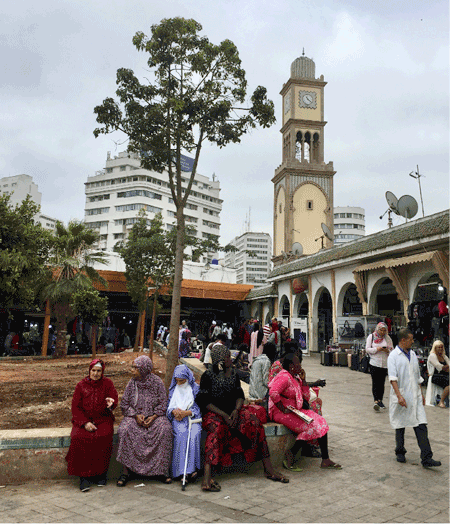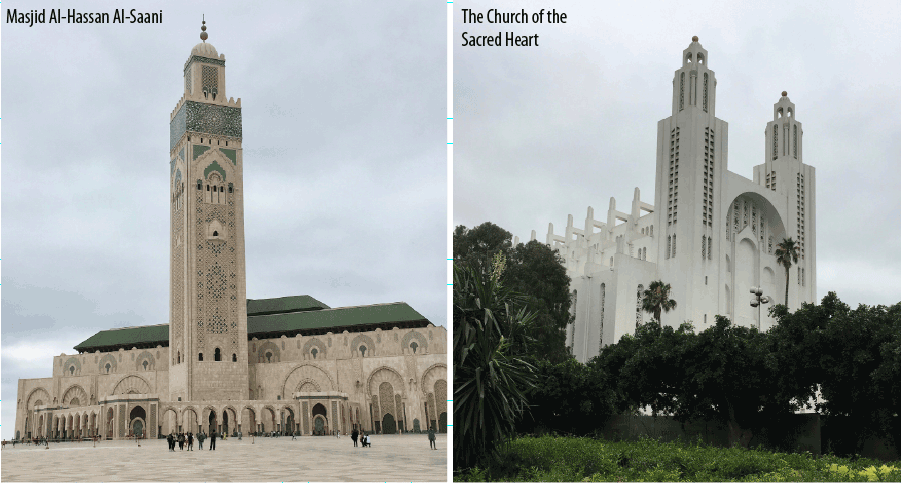Where Tradition Meets Modernity
By Zeenat Hisam | Travel | Published 6 years ago
 “Why are you going to Morocco? What is there to see?’ asked the officer who stamped our passports at the Jinnah International Airport, Karachi. He was not the only one to wonder: a few friends and relatives had also looked at us quizzically. Morocco I associated, first and foremost, with Fatima Mernissi, the sociologist, writer, Islamic scholar and feminist whose work I came across and read with fascination in the 1980s. Then two decades later, it was Tahar Ben Jalloun’s Leaving Tangier and A Palace in the Old Village, Laila Lalami’s Hope and Other Dangerous Pursuits and Youssef Fadel’s A Beautiful White Cat Walks with Me –sad and gripping stories of migration, home-coming, clash of tradition with modernity, constitutional monarchy and its pomp and power, conflict with the Saharawi desert people – revealing the dark, seamy side of Morocco and the frailties and foibles of humanity residing in an ancient land nine miles away from Spain if you cross via the Strait of Gibraltar, from where Tariq bin Ziyad led the Muslim conquest of Spain in 711 AD.
“Why are you going to Morocco? What is there to see?’ asked the officer who stamped our passports at the Jinnah International Airport, Karachi. He was not the only one to wonder: a few friends and relatives had also looked at us quizzically. Morocco I associated, first and foremost, with Fatima Mernissi, the sociologist, writer, Islamic scholar and feminist whose work I came across and read with fascination in the 1980s. Then two decades later, it was Tahar Ben Jalloun’s Leaving Tangier and A Palace in the Old Village, Laila Lalami’s Hope and Other Dangerous Pursuits and Youssef Fadel’s A Beautiful White Cat Walks with Me –sad and gripping stories of migration, home-coming, clash of tradition with modernity, constitutional monarchy and its pomp and power, conflict with the Saharawi desert people – revealing the dark, seamy side of Morocco and the frailties and foibles of humanity residing in an ancient land nine miles away from Spain if you cross via the Strait of Gibraltar, from where Tariq bin Ziyad led the Muslim conquest of Spain in 711 AD.
So, we set out to discover a little bit of the country and its people I know very little about. Delightfully, Morocco made us – mother and daughter – feel at home. To begin with, people are in all shades of brown, ivory and black. The similar skin colour gives us a sense of belonging and not of alienation as it does when we visit the western countries. Secondly, Arabic, a language familiar to us though not understood, sounds soft and silky to our ears and we could greet people with salaam alaikum which ensured a prompt reply. Thirdly, somehow we felt safe as men, in general, do not stare at women (including female foreigners dressed scantily). I found Moroccan Muslims tolerant and good-natured, rubbing shoulders with foreigners in narrow alleys. We encountered women in abaya, hijab and burqa, and men in djellaba passing by all types of foreigners without a grimace or unpleasant expression. If you smile at them, they smile back; if you greet them they return the greetings, otherwise they go about their business. ‘Can it happen in Pakistan!’ I used to wonder, where at times even local women have to face harsh and disapproving look if ‘violating’ the ‘accepted’ dress code.
We could see foreigners wherever we roamed – Casablanca, Rabat, Chefchaouen, Tetouen, Fes, Marrakech. Tourism plays a dominant role in Morocco’s economic development, contributing 8.1 per cent to the country’s GDP (2016 figures), providing jobs to around 5 per cent of its labour force and attracting over 10 million tourists annually.
Morocco has put the required strategies, infrastructure and institutions in place for tourism to thrive. Its railway stations are modern, inter-city bus stations have all the facilities and its workforce is trained in the art of hospitality. The state continues to preserve, maintain and restore historical monuments and madinas and keep up development in the new parts of the cities.
Casablanca, the port city and commercial hub, reminds you fleetingly of Karachi: a city without a distinct character of its own and its centre a mishmash of colonial buildings, bland offices and residential structures. What sets it apart from Karachi is its public squares surrounded by roadside cafes, street art and public transport system in place and, of course, its population which is around 4 million compared to Karachi’s 16 million! A 31-km tramway system, built in 2012, connects the east and western parts of the city with the centre. Shared taxis, kabira (big) and saghira (small), provide metered services. At kabira taxi stands, people queue up. We did not come across many buses. Probably the bus system is deficient. Though the French ruled Morocco only for 44 years (1912-1956), a colonial legacy persists: French, the second official language, is the language of economics and commerce, academia and the elite. The majority speaks Arabic.

A pavement bookshop.
On arrival in Casablanca in the morning, we slept like a log after the long air travel. In the afternoon, we had an early supper at a local eatery on Boulevard Moulay Hassan close to our hotel. A husband-wife team, warm and smiling, served us harira, a thick lentil and chickpea soup and tagine, the Moroccan dish we selected. Tagine is a traditional ceramic plate with a matching conical lid. The ingredients of the dish are usually a mix of meat, vegetables, dry fruit and light spices cooked on low heat and served individually. Moroccan breads or khobz are a variety of rolls, buns, loaves and pancakes made of different flours, barley, rice and sprinkled with crushed anise seeds, sesame seeds, etc. The most famous dish is couscous, made of flour from durum wheat which grows in the arid region, stewed along with a variety of vegetables and meat. Couscous is cooked traditionally on Fridays in Moroccan households and many roadside eateries stick to this tradition. When you are in Morocco, remember Friday as the couscous day! Moroccan mint tea, taken with a lot of fresh mint leaves in the glass, we found very refreshing, no matter what time of the day or night we sipped it.

Old city square.
With intricate tile-work in pale blue, ivory and sea green, and its grand horseshoe arches, marble columns and fountains, the structure of the Hassan II Mosque is an exquisite blend of traditional and modern aesthetic sensibilities. I learned that part of the mosque’s floor is made of glass and the worshippers kneel directly over the sea. But this feature is now for royal use and off-limits to visitors, and so is the sliding roof of the mosque which opens occasionally. I was told by my friend Zubeida Mustafa that, when she had visited Morocco to receive the Global Media Award for Excellence in 2004, the roof of the mosque was opened for the delegation and ‘you get an exhilarating sense of the vast space opening up.’
The women’s praying gallery is made of beautifully carved wood. Adjacent to the mosque, the area includes a madrasa, a huge library, a traditional hammam and a museum.
The expansive mosque courtyard bustled with families – children, women in abayas of all colours and headscarves, men in djellabas or jeans. We spotted a group of little girls in pink shirts and trousers and white caps, exploring nooks and corners led by their teacher, on what seemed to be a school field trip. There were many women offering prayers when we went to the women’s section. The vast courtyard of the mosque leads to the tip of the Corniche, a boulevard that runs along the coast. The promenade hummed with activity with vendors selling stuff, children skating and people sitting on the wall. Several families had ventured down the ridge and the stony bed full of weeds onto the shallow Atlantic waters. In the backdrop of the magnificent mosque, the vast Atlantic Ocean was dull grey under a cloudy sky. We sat on the promenade wall and ate french fries served on a spiral stick and a fish samosa that I bought from a woman vendor.

From the mosque we went to the gate of the old madina and sat in the square for a while. We had learned prior to our journey that the old city in Casablanca, which has existed for centuries is not comparable to the historic old parts, the madinas, of Fes and Marakech, and their luring souks full of exquisite merchandise. So we decided to skip a stroll inside the walled city and walked down farther. The Church of the Sacred Heart, a former Roman Catholic church built in 1930, looked imposing in its white twin towers. Turned into a cultural centre, the church was closed for repairs when we visited it. In fact, whatever little we saw of the city – its roads, promenades, pathways, buildings – looked like it was under perennial construction and repair. Later I learnt about the Great Casablanca Region Development Plan 2015-2020, an ambitious plan to turn around the city into an international financial hub and bring it at par with other global cities. Adjacent to the Church, the Arab League Park, the green space at the city centre covering 30 acres, bisected by Moulay Yussef Boulevard, looked majestic with hundreds of palm trees planted in rows. The park, which existed prior to the 19th century, was redesigned in 1913. Under the current development plan, it has been renovated and upgraded in the last three years. Sitting on the bench, soaking in the quietude and the afternoon warmth, we watched the groups of old men walking by and chatting.

A woman and her daughters dip their hands in a mosque fountain.
The moment we had checked into our hotel at Casablanca, I was reminded of the Hollywood movie as jazz and soft blues wafted through the air in the corridors, inside the elevator and the hotel’s restaurant. Though it was not “As Time Goes By,” the theme song of the movie, I noticed that several street cafes played jazz tunes and old songs. I learnt later that the city has so many jazz lovers that since 2006 a music festival called Jazzablanca is hosted annually to celebrate the story ‘of a meeting between music, jazz and Casablanca! Unfortunately, we missed the festival which ran from 2 to 7 July 2019 as we arrived a week later. The city is associated by the people of my age (60 plus) with the Hollywood movie Casablanca. So, the next morning we headed to have a look at the famed Rick’s Café of the 1942 Hollywood’s black and white classic movie Casablanca which was entirely filmed in a studio in California and not in Casablanca, as I always thought! The fictional café of the film was materialised in 2004 by Kathy Kriger, an American diplomat who had served as US Ambassador in Morocco. Enchanted by the country, she bought and renovated an old mansion in Casablanca and founded a company The Usual Suspects to run Rick’s Café. Today, the restaurant, bar and café is a favourite haunt of tourists and the elite of the city. We sat in a park across the street and returned to the hotel to pack our bags and leave for Rabat, the capital city, via train.


